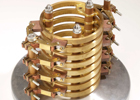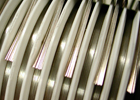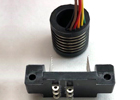High Reliability Slip Ring Design for Wind Turbines
October 29, 2019
October 29, 2019
Find the best slip ring solution for your wind turbine application to achieve optimal performance and reliability.
Most modern wind turbines require electrical power and signals to be delivered to the blades for blade pitch actuation. This transmission of electrical power and signals is most efficiently accomplished with a slip ring. With differing designs and contact technology options available, how do you know which slip ring to choose?
Choosing the right wind turbine slip ring starts with understanding important wind turbine characteristics and how available contact technologies fit into your power and signal transmission requirements and maintenance needs.
Wind turbine applications present a significant challenge for slip rings due to the combination of unique requirements material and design selections must meet. There are five important characteristics of wind turbines that require specialized slip ring design considerations: (1) operational life, (2) environment, (3) electrical requirements, (4) maintainability goals and (5) reliability requirements. These parameters are critical in the selection of sliding contact materials used in wind turbine slip ring assemblies as well as the housing that protects these electrical contacts from the environment.
The chart below explains how each characteristic relates to slip ring performance.
| Life | Continuous rotation at 30 RPM for 100 million cycles or more requires contact materials with an exceptionally good wear rate. |
| Environment | Contacts must be robust to survive nacelle environments. The materials must tolerate the humidity, temperature, and contamination environments that can be present, and the assembly must be appropriately sealed. |
| Electrical Requirements | Typical slip rings have power requirements as well as signal transfer requirements. The contact material must have good power (current) capacity as well as low contact resistance for good signal transmission. |
| Maintainabaility | Contacts should not degrade significantly with time or be subject to sudden catastrophic failure as long as specified inspection or maintenance procedures are followed. |
| Reliability | Contacts should require little or no maintenance. Any wear debris must be carefully managed to avoid arcing or short circuits. |
Choosing the proper contact design for your application is critical to slip ring performance, reliability and maintenance requirements. Properly designed signal contacts will deliver intimate contact (necessary for error-free electrical and arc-free power transmission) and minimize signal variation for optimal signal transmission. In addition, they should incorporate materials and design criteria that reduce wear from contact during sliding.
Moog highlights three (3) commonly used contact systems that solve these requirements for wind turbine power and signal transfer: (1) carbon / metal brushes, (2) fiber brushes and (3) monofilament (single) metal brushes. Each offers distinct advantages and disadvantages, dependent upon your wind turbine characteristics.
The carbon / metal brush has historically been used for wind turbine slip rings, electric motor commutation (almost exclusively performed by this brush type) and is commonly used in high power industrial slip rings as well. These brushes shed wear debris, by design. However, proper material and design selection, inspection and cleaning reduce the amount of wear debris and build-up produced.
These brushes are ideal for low to mid-power transmission, as well as signal and data channels. Fiber brushes have multiple contact points. This allows for even sharing of electrical and mechanical loads, resulting in light contact forces per contact point and very low debris generation. Over time, they’ve evolved to improve the efficiency of high performance motor and generator communicator contacts, with notable applications including helicopter rotor de-icing, radar pedestal and wind turbine slip rings.
Monofilament brushes can be used in hybrid systems to carry signals and data but are not very effective with power transmission. They’re normally alloys of gold, silver or other noble metal and are typically used in pairs to reduce contact resistance variation with rotation. The ring material is often made with noble metal as well, with hard gold or hard silver being the most common. Noble metal materials allow for low brush force, resulting in low wear and contact resistance.
| Contact Design | Advantages | Disadvantages |
|---|---|---|
| Carbon / Metal Brush |
|
Sheds wear debris by design |
Fiber Brush |
|
|
| Monofilament (Single) Brush |
|
Not effective with power transmission |
*Results based on test stopped at 124 million revolutions with no indication that contacts were at the “end of life.”
Life, maintenance and operation cycles mentioned are based on proper maintenance. Extensive life testing conducted to verify all performance characteristics.
Conclusion
No sliding contact system is inherently more reliable than another — reliability must be designed into the entire slip ring assembly. The 'optimal’ slip ring solution depends on the unique set of requirements for your specific wind turbine, such as environment, power and data requirements and maintenance schedules. The key to the optimal contact system is recognizing that contacts must be integrated into a reliable overall system design (with proper ring spacing, barrier design, creep paths, structure and bearing design) and following proper inspection, maintenance schedules and procedures. As is often the case in any engineering solution, proper contact selection involves weighing tradeoffs. It is important to consider all aspects of the application, along with the relative advantages and disadvantages of different contact designs, when evaluating the ‘best’ contact solution.
The Moog advantage is forged in years of continuous research and experience with three different contact systems (carbon, fiber and monofilament). Get unparalleled expertise, innovative engineering and reliable performance for your wind turbine needs with Moog.


